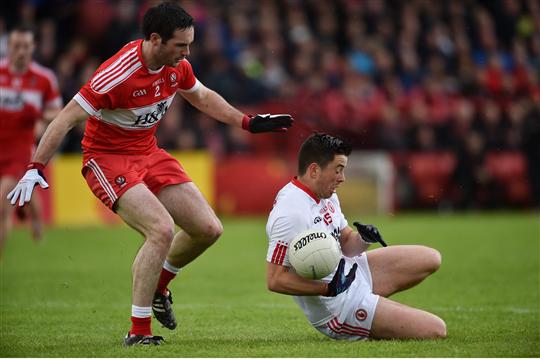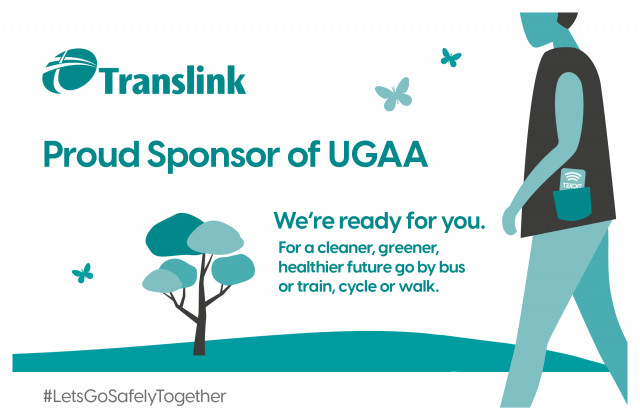Derry v Tyrone Statistical Analysis

USFC 2016: Derry v Tyrone, Quarter Final, Celtic Park
Performance analysis has become a major component of the coaching process. A combination of statistical information and video clips allow coaches to analyse performance and provide feedback on both individual and team performance. The same process also allows a coaching team to establish positives and negatives from each performance, and should provide them with a guide as to the needs of the team in subsequent training sessions.
Throughout the Ulster Senior football championship 2016, Ulster GAA will be providing statistical analysis, supported by video clips analysing each game.
Possession
Possession is considered a key factor in match analysis, despite the fact little evidence exists to suggest superior possession share relates to successful outcome. In many sports, possession is measured as percentage of time spent on the ball. However, in GAA, it is more pertinent to assess possession as a count – the number of possessions each team has during a game.
On Sunday past, Tyrone enjoyed a greater number of possessions (47 versus 44). They were able to sustain this advantage through the various stages of possession, and ultimately secure the greater number of scores required to win the match.

Tyrone’s superior possession share was due, in part, to their marginal victory in the kick out battle, 52% to 48%. It is key to remember that this advantage was as little as a single kick out, so given the margin of victory, the reason certainly does not lie in the balance of kick out possession. Derry only had one more turnover than Tyrone (Derry – 21, Tyrone – 20), further backing up the idea that possession share was not the key factor in Tyrone’s victory margin of 11 points.
While possession share was not key to the outcome, Derry did allow Tyrone 11 short kick outs, 10 of which resulted in simple possession for Tyrone. When Derry forced the Tyrone kick out to be taken to contested areas they performed very well, winning 62% of Tyrone kick outs. Tyrone were able to exert similar, albeit less dominant, pressure when forcing Derry to take contested kicks, winning 52% of Derry kick outs taken to longer areas.
As with the preliminary round game, there is clear evidence that attempting to prevent your opponent taking advantage of short kick outs could prove hugely beneficial to a team’s chances of winning the possession battle. That said, in this game, Tyrone were very proficient at taking short kick outs before Derry had the opportunity to apply requisite pressure. It was notable that the Tyrone goalkeeper was able to use either foot to take short kick out, making the prevention of this option all the more difficult.
Efficiency in Possession
A key reason that higher possession count does not necessarily point to winning outcomes is the ability of a team to convert possession to the scoreboard. By breaking down each possession to stages it can help establish where / how a team is failing in their use of possession. When a team secures possession inside their opponent’s 45m line it can be considered an attack.
One clear difference between the two teams lay in Tyrone’s ability to create shooting chances when in the scoring zone. Tyrone generated shots from 84% of attacks, while Derry only managed to create shots from 75% of attacks. More tellingly, Tyrone converted an Ulster Championship 2016 high of 55% of shots, while Derry only managed to scores from 44% of attempts. Derry’s return was certainly not disasterous, and would see them win many matches, but Tyrone’s clinical performance in front of goal would render them almost impossible to defeat, especially considering they also won the battle for possession.

Productivity
Productivity is a measure that defines the impact a team has on the scoreboard, relative to the number of possessions they have. It calculates how many total points a team register for every 10 possessions. The calculation considers the value goals can have on performance. Typically, although not true of every match, a value of 3.0 will be sufficient for a team to be on the right side of the result – that is, a team that registers 3 points from every 10 possessions will regularly win the match.
Sunday past, witnessed the most productive performance of any team in the Ulster Championship over the past 3 seasons (since first use of productivity measurement). Tyrone returned a value of 4.9, which equated to a return of almost a point from every 2 possessions. Tyrone’s impressive return owed largely to their 3 first half goals, and was backed up by some impressive shooting for points.
In contrast, Derry struggled to attain the 3.0 threshold, and while 2.7 is not an overly poor return, it was vastly inferior to their opponent. Some good defensive organisation from Tyrone forced Derry to take some ‘low percentage’ shots from range, and when Derry did get closer some excellent pressure prevented Derry having a greater impact on the scoreboard.

Derry – lessons for training
Overall, Derry produced a statistically sound performance. However, one major failing was goals conceded – most worryingly will be that each of the goals were as a result of Tyrone building from deep in their own defence. Better resilience to these counter attacks combined with other factors could have left the game much tighter in the closing stages. From a coaching perspective, Derry may look at the following key areas to improve ahead of their first qualifying match;
- Shot success rate of 44% was too low, with some poor shot selection, both outside the high percentage zone, and when under pressure;
- Quicker organisation to prevent opponent taking short kick outs, and force longer kicks to contested areas, where Derry seem to excel;
- Defensive effectiveness throughout the pitch, with all 3 Tyrone goals coming from deep, taking an average of 24 seconds from gaining possession to the shot being taken. Derry did not get organised well enough defensively to prevent the goal scoring chances.
Tyrone – lessons for training
Tyrone delivered a superb performance, both offensively and defensively, and it is easy to overlook potential weaknesses and areas to improve ahead of their semi-final clash. However, there were a number of aspects that potential opponents may look to exploit and Tyrone will need to be aware of these and prepare well;
- Reliance upon short kick outs – when Derry slowed the kick outs and forced the kick to be contested, Tyrone only managed to win 38% of their own kicks;
- Tyrone conceded 7 free kicks in their defensive zone, so while they appear to be well organised, with numbers back, they are prone to conceding free kicks. Potential opponents need to be aware of the potential rewards from being direct when faced with a Tyrone opponent;
- Despite their excellent shooting, they had 5 shots that came up short, providing an immediate opportunity for an opponent to counter attack, and while not exploited by Derry, this could be costly in future games.







